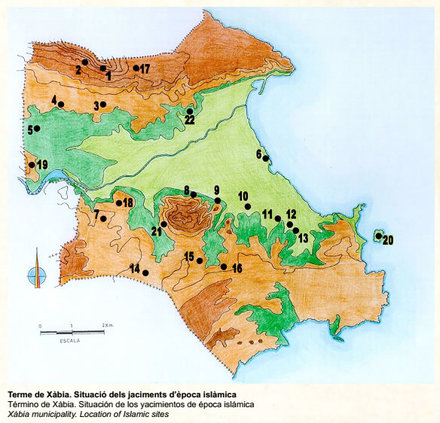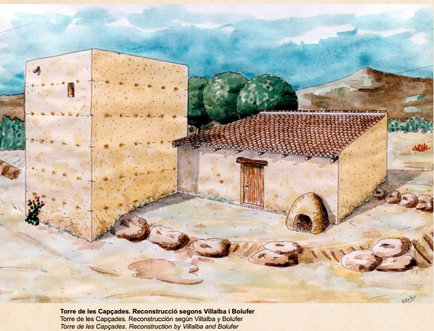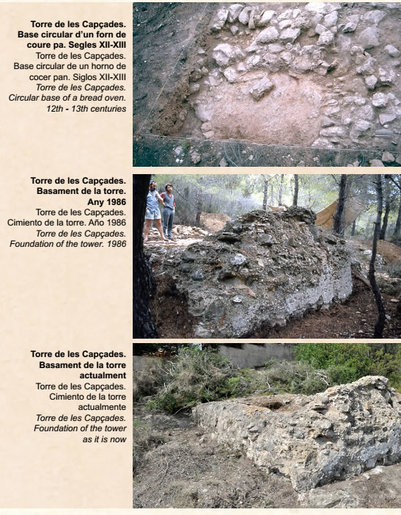|
The only defensive structure recorded archaeologically is the tower of Capçades, situated on the slopes of one of the small hills which bound the southern area of the Plá, some distance from the most fertile lands.
The tower consists of a solid foundation of 5.60 x 3.85 metres and a maximum preserved height of around 1.70m constructed with lime mortar and pebbles, finished on the exterior with a coat of lime mortar. Originally it was least two stories high with a flat terrace giving a view of the valley and a good part of the bay, and serving as a refuge for nearby inhabitants. The west side of the tower supports a building of which only two walls remain, with a threshold and a bread oven built against the outer wall. This construction is typical of the few remains of farmsteads built around towers. Archaeological finds indicate that it was inhabited from the end of the 11th century until a little after the Christian conquest. |
In Islamic times the Xàbia valley was characterised by many small settlements (we know of more than 20) which formed part of various farmsteads into which the area was organised . The majority were situated at the foot of the mountain, near agricultural lands. However, some were on rugged areas, such as the Plana Justa and the Montgó, where farming would be oriented towards grazing animals. There were also settlements on the coast dedicated to fishing and trade, such as those documented on the island of Portixol or la Fontana point.
The defining elements of these settlements is the amount of ceramics on the surface, and the silos or ‘pou de moros’, as they are popularly known. These structures were excavated in the white marl subsoil. They have a circular mouth about 0.50 metres wide, are bell-shaped or globular in profile and 1.5 to 2 metres deep. The pits were used to store cereal crops, keeping them away from damp, rodents and insects. They were used as food stores for the community, as well as supplies to sell and earn money to pay taxes. There is no documented evidence about the political and social organisation of Xàbia in Islamic times. It is thought that the castle upon which the farmsteads depended was that of Denia, whose distance away meant that larger settlements erected watch towers as refuges in case of danger. |
- Home
- Blogs
-
Projectes
- Premio de Investigación - Formularios de Inscripción
-
Traducciones Translations
>
-
DISPLAY PANELS - GROUND FLOOR
>
- THE STONE AGES - PALAEOLITHIC, EPIPALAEOLITHIC AND NEOLITHIC
- CAVE PAINTINGS (ARTE RUPESTRE)
- CHALCOLITHIC (Copper) & BRONZE AGES
- THE IBERIAN CULTURE (THE IRON AGE)
- THE IBERIAN TREASURE OF XÀBIA
- THE ROMAN SETTLEMENTS OF XÀBIA
- THE ROMAN SITE AT PUNTA DE L'ARENAL
- THE MUNTANYAR NECROPOLIS
- ARCHITECTURAL DECORATIONS OF THE PUNTA DE L'ARENAL
- THE ATZÚBIA SITE
- THE MINYANA SMITHY
- Translations archive
- Quaderns: Versión castellana >
- Quaderns: English versions >
-
DISPLAY PANELS - GROUND FLOOR
>
- Catálogo de castillos regionales >
- Exposició - Castells Andalusins >
- Exposición - Castillos Andalusíes >
- Exhibition - Islamic castles >
- Sylvia A. Schofield - Libros donados
- Mejorar la entrada/improve the entrance >
-
Historia y enlaces
-
Historía de Xàbia
>
- Els papers de l'arxiu, Xàbia / los papeles del archivo
- La Cova del Barranc del Migdia
- El Vell Cementeri de Xàbia
- El Torpedinament del Vapor Germanine
- El Saladar i les Salines
- La Telegrafía y la Casa de Cable
- Pescadores de Xàbia
- La Caseta de Biot
- Castell de la Granadella
- La Guerra Civil / the Spanish civil war >
- History of Xàbia (English articles) >
- Charlas y excursiones / talks and excursions >
- Investigacions del museu - Museum investigations
- Enllaços
- Enlaces
- Links
-
Historía de Xàbia
>
- Social media
- Visitas virtuales
- Tenda Tienda Shop




